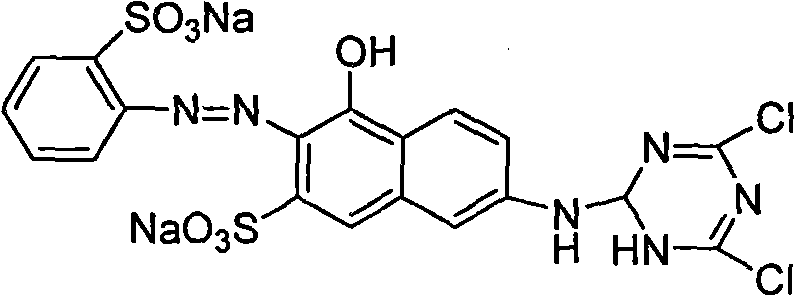Method for producing coagulant for active dye wastewater
A technology for printing and dyeing wastewater and reactive dyes, which is used in textile industry wastewater treatment, flocculation/sedimentation water/sewage treatment, etc. Effect
- Summary
- Abstract
- Description
- Claims
- Application Information
AI Technical Summary
Problems solved by technology
Method used
Image
Examples
Embodiment 1
[0052] A: Polyvinyl alcohol (1750±50) 50g
[0053] Na 2 SiO 3 100g, deionized water 10×90g
[0054] Stir at 95°C for 6 hours to obtain A with a solid content of 14% and pH=7.5
[0055] B: Bisphenol S type epoxy resin 50g
[0056] The preparation method of bisphenol S type epoxy resin is known aqueous solution polymerization or inverse emulsion polymerization. We adopt the aqueous solution method, add 25 grams of bisphenol S, deionized water and additives into a three-necked flask, add a small amount of sodium hydroxide to adjust the pH to 9-10, add 9.25 grams of epichlorohydrin dropwise, keep the temperature at 40-60ηC, and place The polymerization reaction is carried out in a constant temperature water bath for 0.5-6 hours, and the homogeneous solution is diluted with water to obtain an aqueous solution with a solid content of 40%. The molar ratio of raw materials is: bisphenol S: epichlorohydrin = 1: 1. 50 grams of deionized water. Heated at 60°C for 2h and stirred...
Embodiment 2
[0063] A: In the preparation method of polyethylene, sodium silicate is changed to NaOH
[0064] B, C, D are the same as above
[0065] A: 12 parts, B: 83 parts, C: 5 parts, heated at 50°C in a three-necked flask with a condenser, stirred for 1 hour, and cooled for later use.
[0066] In actual use, one part of the above-mentioned mixture of A, B and C, and one part of component D are used in combination.
Embodiment 3
[0068] A, B (sodium silicate is changed to sodium phosphate), C, D preparation methods are the same as above
[0069] A: 6 parts, B: 86 parts, C: 8 parts. Heat to 50°C with a three-necked flask with a condenser, stir for 18 hours, and cool for later use.
[0070] In actual use, one part of the above-mentioned mixture of A, B and C, and one part of component D are used in combination.
[0071] Table 1 Effects of coagulation and decolorization agent for printing and dyeing wastewater of compound reactive dyes
[0072] decolorizer
Dosage (ppm)
pH value of coagulation tank
COD (mg / L)
Chroma
0
60
6.5
650
49
Example 1 *
100
60
7.2
75
4
Example 2
120
65
7.5
88
8
Example 3
120
65
7.7
79
8
[0073] Note: 1. The experimental wastewater is the wastewater dilution solution of Zhejiang Jinding Ribbon Printing...
PUM
| Property | Measurement | Unit |
|---|---|---|
| decolorization rate | aaaaa | aaaaa |
Abstract
Description
Claims
Application Information
 Login to View More
Login to View More - R&D Engineer
- R&D Manager
- IP Professional
- Industry Leading Data Capabilities
- Powerful AI technology
- Patent DNA Extraction
Browse by: Latest US Patents, China's latest patents, Technical Efficacy Thesaurus, Application Domain, Technology Topic, Popular Technical Reports.
© 2024 PatSnap. All rights reserved.Legal|Privacy policy|Modern Slavery Act Transparency Statement|Sitemap|About US| Contact US: help@patsnap.com










